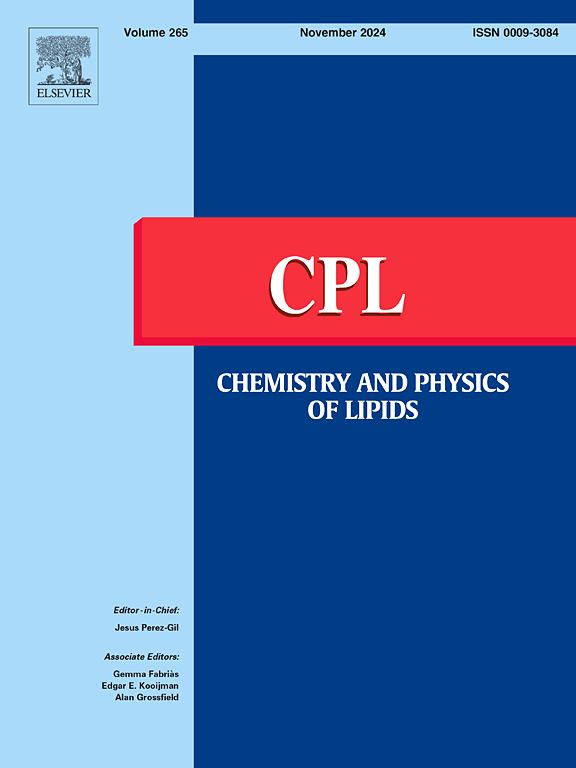Tocopherols and tocotrienols. A molecular dynamics study
IF 2.8
3区 生物学
Q2 BIOCHEMISTRY & MOLECULAR BIOLOGY
引用次数: 0
Abstract
Vitamin E denotes a cluster of eight molecules, i.e., α-tocopherol, β-tocopherol, δ-tocopherol, γ-tocopherol, α-tocotrienol, β-tocotrienol, δ-tocotrienol and γ-tocotrienol, where the α-tocopherol isoform is the major form. Vitamin E is one of the natural most potent antioxidants and an indispensable molecule for human health, since its major function is the inhibition of free-radical lipid peroxidation propagation. Vitamin E has a lipophilic nature and localize in membranes and lipoproteins and could affect either both its biological properties or membrane structure. I have used molecular dynamics to know the position and orientation of these eight biomolecules in water and inside a biomembrane, besides finding any interactions with their lipidic components. When they are in the membrane, all molecules tend towards their most extended conformation, inserting well between the phospholipid hydrocarbon chains. Our data agree with the general consensus, i.e., the chromanol group is located near the oxygen atom of cholesterol, whereas its hydrophobic chain extends to the membrane middle. This does not prevent the existence of flip-flop between the two monolayers. Significantly, the tocopherol/tocotrienol molecules inside the membrane did not aggregate. Remarkable, α-tocopherol presented a relatively high diffusion coefficient when compared to the other molecules and the α-tocopherol transfer protein seems to be the most suitable for its transport and transfer to the membrane. Although in principle any tocopherol or tocotrienol could function as an antioxidant, nature has chosen α-tocopherol thanks to the sum of a series of very subtle characteristics.
生育酚和生育三烯醇。分子动力学研究
维生素E是由α-生育酚、β-生育酚、δ-生育酚、γ-生育酚、α-生育三烯醇、β-生育三烯醇、δ-生育三烯醇和γ-生育三烯醇等8个分子组成的簇,其中α-生育酚异构体为主要形式。维生素E是天然最有效的抗氧化剂之一,对人体健康是不可缺少的分子,因为它的主要功能是抑制自由基脂质过氧化增殖。维生素E具有亲脂性,可定位于膜和脂蛋白中,影响其生物学特性或膜结构。我用分子动力学来了解这八种生物分子在水中和生物膜内的位置和方向,并发现它们与脂质成分的相互作用。当它们在膜上时,所有分子都倾向于它们最大的构象,插入磷脂烃链之间。我们的数据与一般的共识一致,即铬醇基位于胆固醇的氧原子附近,而其疏水链则延伸到膜的中间。这并不能阻止两个单层之间的触发器的存在。值得注意的是,膜内的生育酚/生育三烯酚分子没有聚集。值得注意的是,α-生育酚与其他分子相比具有较高的扩散系数,α-生育酚转移蛋白似乎最适合其转运并转移到膜上。虽然原则上任何生育酚或生育三烯醇都可以起到抗氧化剂的作用,但大自然选择了α-生育酚,这要归功于一系列非常微妙的特性的总和。
本文章由计算机程序翻译,如有差异,请以英文原文为准。
求助全文
约1分钟内获得全文
求助全文
来源期刊

Chemistry and Physics of Lipids
生物-生化与分子生物学
CiteScore
7.60
自引率
2.90%
发文量
50
审稿时长
40 days
期刊介绍:
Chemistry and Physics of Lipids publishes research papers and review articles on chemical and physical aspects of lipids with primary emphasis on the relationship of these properties to biological functions and to biomedical applications.
Accordingly, the journal covers: advances in synthetic and analytical lipid methodology; mass-spectrometry of lipids; chemical and physical characterisation of isolated structures; thermodynamics, phase behaviour, topology and dynamics of lipid assemblies; physicochemical studies into lipid-lipid and lipid-protein interactions in lipoproteins and in natural and model membranes; movement of lipids within, across and between membranes; intracellular lipid transfer; structure-function relationships and the nature of lipid-derived second messengers; chemical, physical and functional alterations of lipids induced by free radicals; enzymatic and non-enzymatic mechanisms of lipid peroxidation in cells, tissues, biofluids; oxidative lipidomics; and the role of lipids in the regulation of membrane-dependent biological processes.
 求助内容:
求助内容: 应助结果提醒方式:
应助结果提醒方式:


